Dogwoods are deciduous flowering trees that have ornamental value in the landscape. These native trees can be propagated easily from seed using the right techniques. Learn how to grow a dogwood tree from seed, and spread these beautiful trees throughout your landscape.
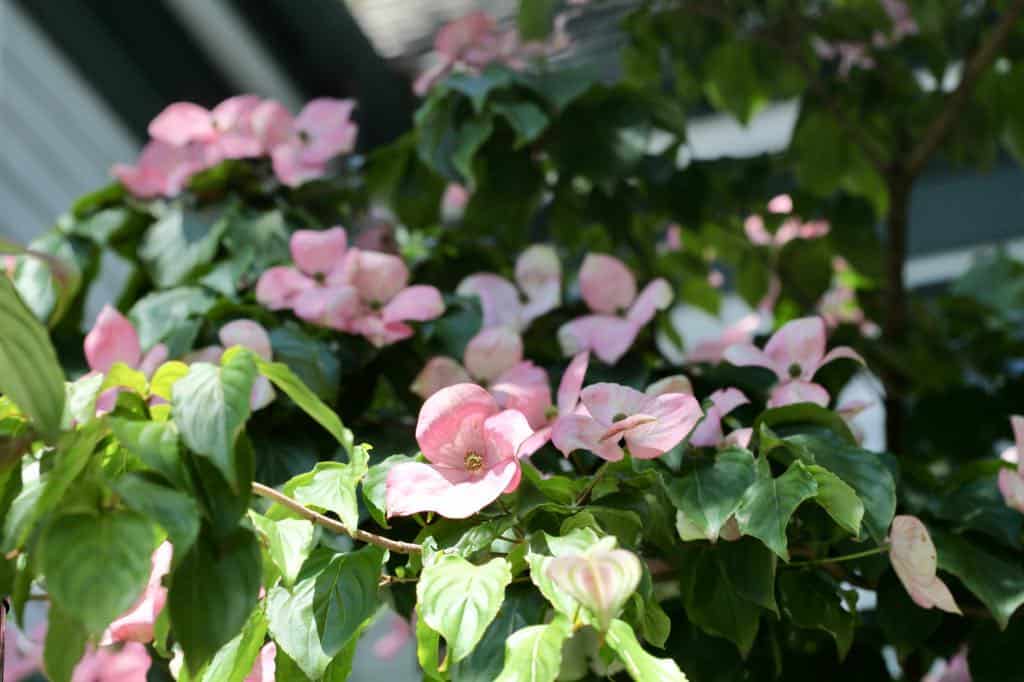
This year I tried my hand at growing dogwood trees from seed, and was pleasantly surprised at the ease of the process.
The seeds were obtained from a special Kousa dogwood, adored by it's owner who wanted to propagate the tree.
In less than a year I now have fifteen tiny trees, which will be planted out to special locations this fall and next spring. It will likely take a good five to seven years before the new trees flower, however it will be worth the wait.
What Is A Dogwood Tree?
There are approximately 30 to 60 different species of dogwood in the genus Cornus, within the family Cornaceae.
Some of the species are flowering trees, while others are shrubs. There is also a species called Cornus canadensis which is a low growing herbaceous perennial found in our Atlantic woodlands.

Popular tree species within this genus include Cornus kousa from Eastern Asia, Cornus Florida from eastern North America, and Cornus nuttallii from western North America. All these species are ornamental deciduous trees, and are valued for their beautiful spring display of showy blooms.

Dogwood Flowers
Dogwood flowers are highly attractive, and have contributed to the appreciation and cultivation of the various dogwood species.
The flowers themselves form in clusters, which are then framed by four to six large petal-like bracts. What people often consider to be the petals, and the showy part of a dogwood flower, are actually the bracts of the flower.
Flower colors range from whites and creams to pinks, with the most common color being white.
When you grow a dogwood tree from seed, the resulting sapling will not be true to the parent, and the end result may get a different colored flowering tree than the parent plant.
Seeds from pink colored dogwood trees will often result in new plants with white flowers, as it is the most common color.

Dogwood Foliage
Dogwood foliage is medium green, with leaves being ovate and opposite.
Leaves on the Kousa dogwood have veining, and are sometimes outlined in pink. The leaves are stiff, and slightly rough to the touch due to small bristle-like hairs on the leaf surface.
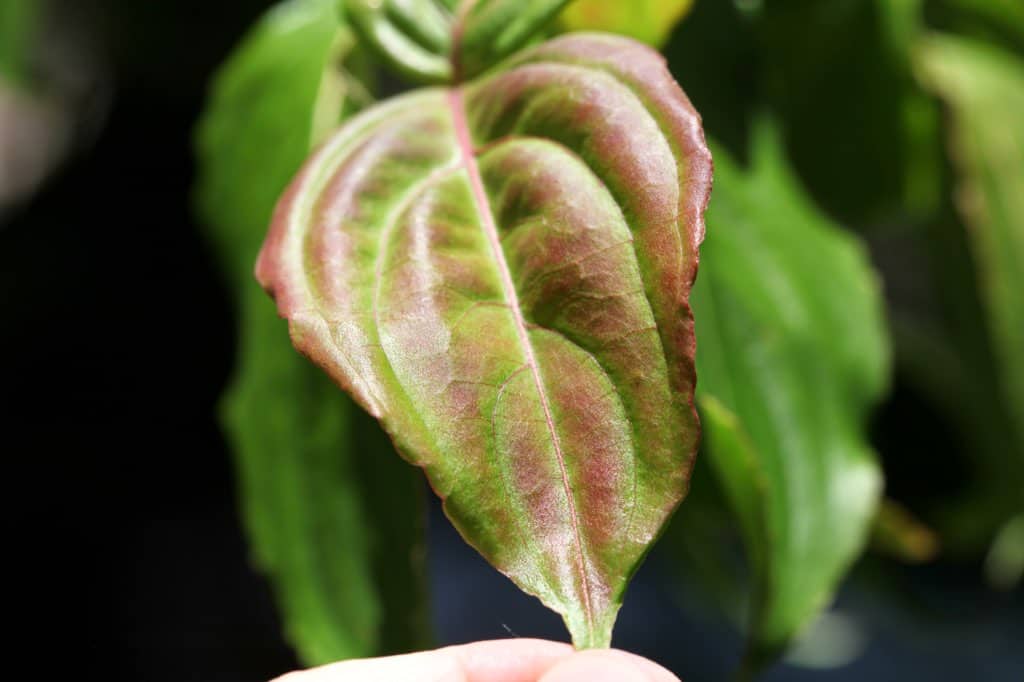
Dogwood Berries
Dogwood berries contain the seeds of the tree.
The red berries are called drupes, and generally contain one or two seeds within. The berries are brightly colored, and often eaten by birds.
If you are planning to save some seeds for propagation, allow the berries to mature on the tree if possible for best results.
Those berries that have fallen to the ground will likely contain mature seeds, and are best for successful germination.
Make sure to get the berries however before the birds get to them, as you will have some competition.

Dogwood Seeds
Dogwood tree seeds can be found in the fruit of the tree.
Cornus kousa Satomi dogwood seeds are a light orange to beige coloration.
The hard seeds are approximately 0.5 cm in length and irregular in shape.
It is important to allow the seeds to mature on the tree for successful germination.
Following harvest, the seeds will require stratification, to prepare them for germination.

Tree Size
Cornus kousa is considered a small ornamental tree and can grow to be approximately 8 to 12 meters in height.
The trees of Cornus Florida are also small, and can grow to be approximately 10 meters high.
Cornus nuttallii, also known as the Pacific dogwood, can grow much taller, and is considered a medium sized tree. This tree can can reach a height of 6 to 23 meters, and a width of 6 meters.
Knowing the tree size is an important consideration when choosing the planting location.

How To Get Seeds From A Dogwood
The seeds of a dogwood are located in the fruit.
Depending on the types of dogwood trees, the berries will contain one or more seeds per berry.
There are a number of ways to get the seeds from the fruit. This is the method that I used:
- Open up the ripe berries and extract the seeds from the pulp.
- Allow the seeds to sit in a container of water for several hours, as this soaking will help to soften the remaining pulp covering the seeds.
- Rub off the remaining fruit from the seeds. It can be a bit difficult, so just remove what you can.
- Then allow the seeds to dry, setting them out onto a surface to complete the drying process.

How To Grow A Dogwood Tree From Seed
Here are the steps to grow a dogwood tree from seed.
The process is quite easy if you follow each of the steps.
The first step is to collect the dogwood seeds.

Collect The Seeds
- To collect seeds from the dogwood, you must first collect the fruit from the tree, in order to access the seeds inside.
- Choose the seeds from healthy trees.
- Remember, the fruit should be mature to get good viable seed which will grow.
- In order to get mature fruit, allow them to ripen, or even over ripen on the tree.
- The best time to collect the fruit is in the late fall.
- Any berries that have fallen to the ground from the tree due their ripeness are ideal, as they will contain mature seeds.

Extract The Seeds
- Extract the seeds from the fleshy drupe and remove the external pulp from around the seeds.
- Rinse the seeds off.
- Allow the clean seeds to dry.
- Now it's time to stratify the seeds.
Stratify The Seeds
- For best dogwood seed germination, the seeds will require stratification.
- Dogwood seeds will need at least a twelve week stratification period prior to planting. This process will help to break down the seed's hard outer coating.
- To stratify, place the seeds into a plastic bag filled with slightly moist peat moss or soilless mix.
- Close the bag and label it with the date.
- Place into the fridge, and keep the seeds in the cold fridge for at least 12 weeks.

Do Dogwood Seeds Need Stratification?
Yes, dogwood seeds require a stratification period.
The chilling period is best when combined with moisture along with the cool temperatures.
The moisture is provided by the moist medium such as peat moss, which will prevent the seeds from being immersed in the water inside the bag.
A cool moist chill will help the seed to break dormancy, and stimulate germination.
With a little moisture in the bag of medium, the seeds will actually begin the germinate in the fridge when they are ready to sprout at the end of the storage period.
Once sprouted, it's time to plant the seeds into a pot of soilless medium to grow on.

Plant The Seeds
When To Plant Dogwood Seeds
- The best time to plant dogwood seeds is in late winter or early spring.
- After the twelve week period, check the seeds to see if any have begun to sprout.
- You will notice a tiny root emerging if this has occurred.
- My seeds were in the fridge for longer than twelve weeks. By the time I got to them, not only had they sprouted, but also had developed their first set of leaves.
- Once germination is evident, it's time to plant the seeds.
- You can also plant seeds which have not yet germinated after the twelve week mark. However, I like to see signs of germination first to make sure that I am not planting any non-viable seeds.
- If there are some seeds still not germinated, return these to the fridge again, and check on them in another few weeks to a month.

Planting The Seeds
- Choose a small planting container with good depth. I choose solo cups which were great temporary pots for the new dogwood seedlings.
- Make sure that the pots have good drainage, and create drainage holes if there are none.
- Fill the pots with a soilless mix, and moisten the mix to compact it and remove any air pockets.
- Make a small hole in the centre of the soil approximately ½ " deep, and plant one dogwood tree seed into each pot.
- Water in gently after planting.
- For more advanced seedlings which may have germinated quickly in the medium, take care not to damage the roots as you remove them from the bag of mulch.
- Also be careful not to plant the seedlings too deeply.
- Sometimes the remains of the seed will have fallen off the seedling at this stage, so it's important to look at the seedling, and differentiate where the stem and root meet.
- The reason for this is to identify the stem of the seedling, and not to plant it too deeply. Plant the root under the soil, while keeping most of the stem above the soil if possible.
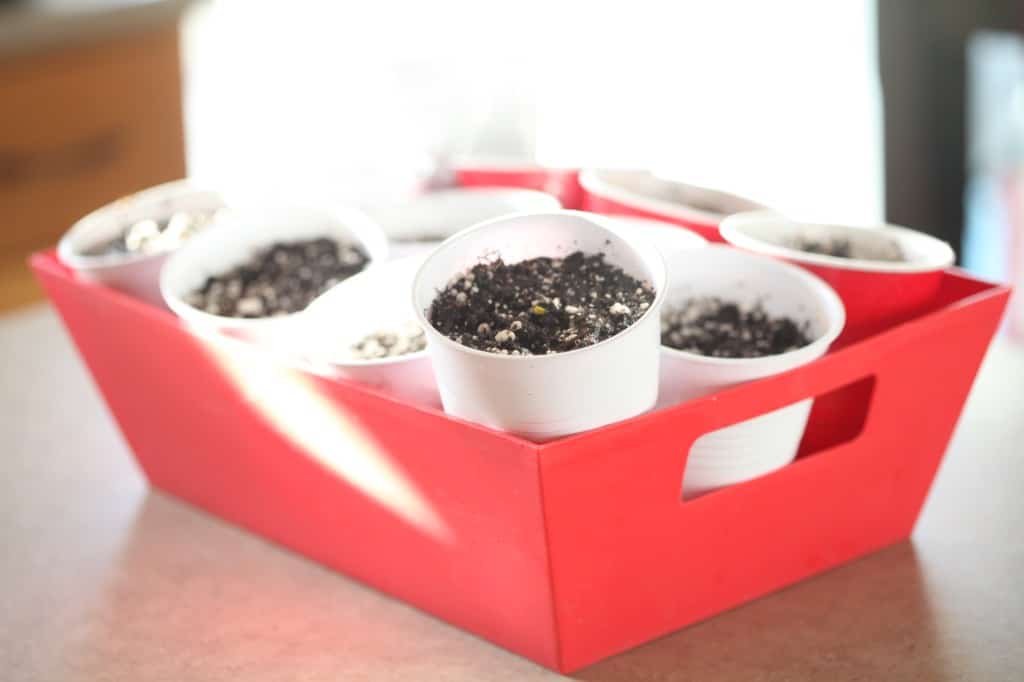
Growing The Saplings
- Once the dogwood saplings are planted, it's time to take care of them until they are large enough to be planted out into the garden.
- The young trees can grow pretty quickly, and may be six to twelve inches at the end of the growing season.
- I was surprised at the unique characteristics between the saplings, as some were slow growing, while others took off and grew more quickly.
- After planting the seeds or saplings, grow under grow lights until the tiny plants can be hardened off and transferred outside.
- Water regularly, allowing the plants to dry slightly between waterings, but not to dry out completely.
- After the last frost date in your area, and once the danger of frost has passed, the small dogwood trees can be hardened off.
- Once hardened off, they can be grown outside in their pots until ready to be transplanted out into the garden.

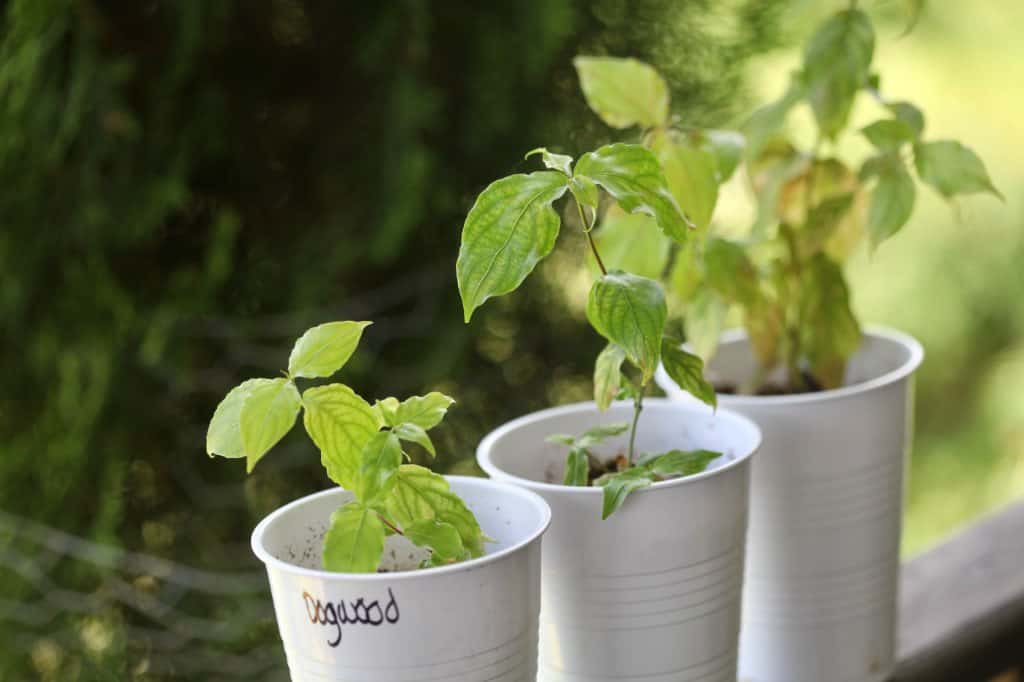

Planting Dogwood Seedlings
When saplings reach approximately 12" in height, they are ready to be planted out with some protection.
Hardiness Zone
- Dogwood trees are hardy in usda plant hardiness zones 5 to 9.
Soil Requirements
- Dogwood trees grow best in fertile soil with lots of organic material, and with a slightly acidic ph level.
- Choose a planting site with well drained soil.
- Consider mulching to maintain moisture. The mulch will also add organic matter to the soil, as it will eventually break down, contributing more humus matter to the growing area.
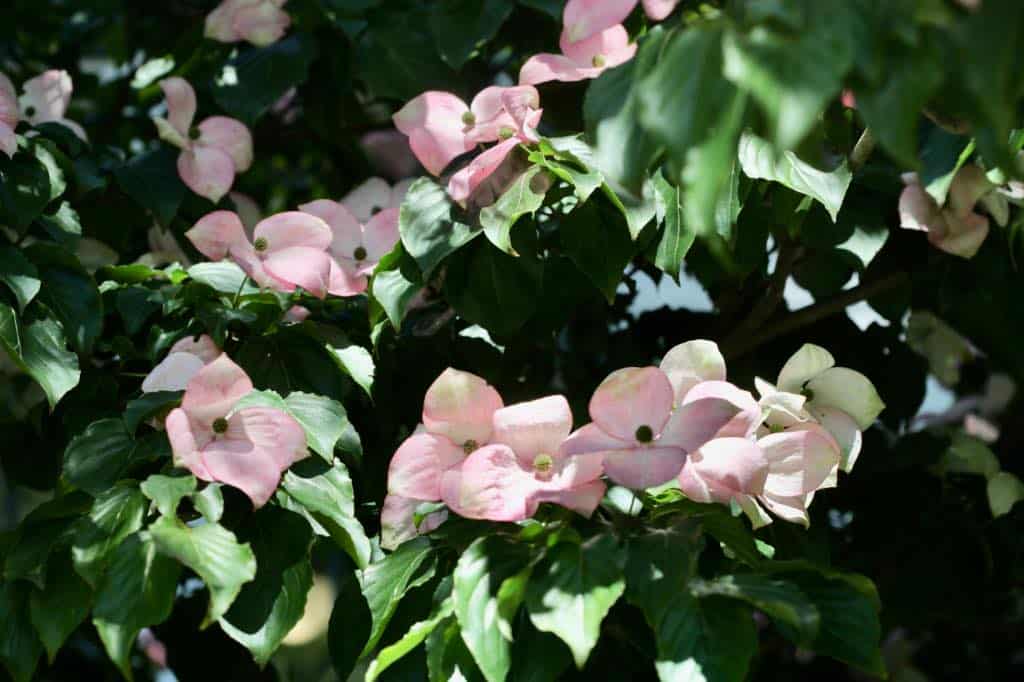
Moisture Requirements
- Dogwood trees benefit from supplemental watering while establishing, along with natural moisture from the outdoor elements.
- Water regularly, especially during dry spells throughout the growing season.
- Place mulch on top of the soil around the base of the tree, to help to conserve the moisture in the soil.
Light Requirements
- Dogwoods grow best in partial shade, however will also tolerate a sunny area or a shaded spot.
- For best results, plant dogwood trees in a partial shade location. These trees naturally would have had some protection from larger plantings around them, as they are considered to be understory plants.
- If planting in full sun, the trees will require more water than in a shaded area.
- If planting near a foundation, consider the final height of the trees. A foundation planting will provide a more sheltered spot if needed.
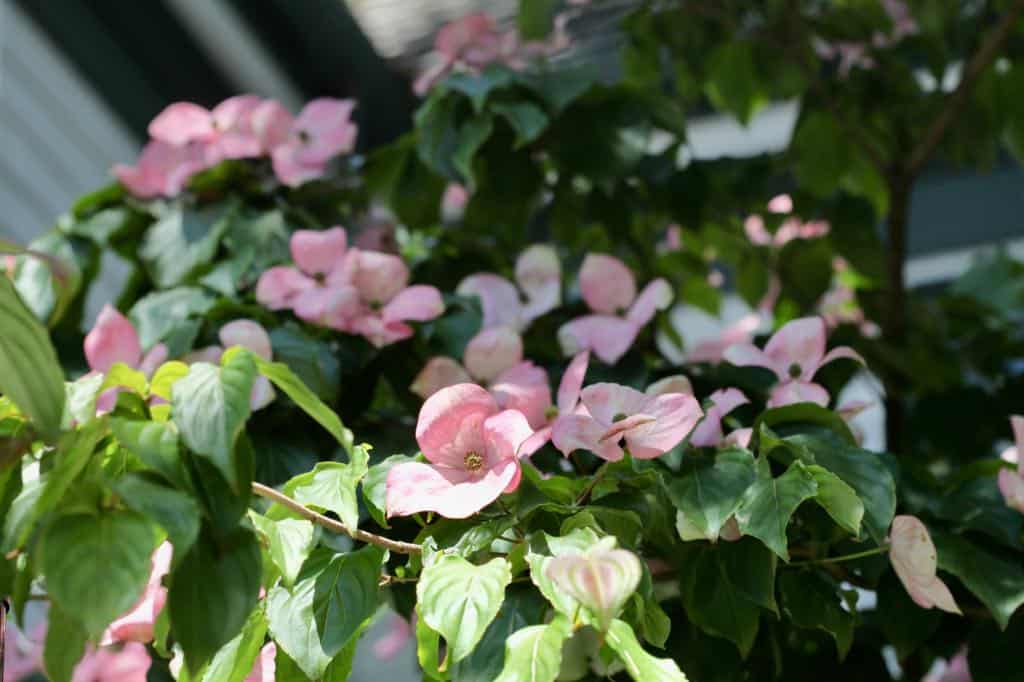
Protect The Tender Saplings
- Consider a tree sleeve to cover the tender sapling trunk, which will help to protect it from injury, while the tree grows and becomes established.
- Staking is also a good idea, and will mark the location of the small tree to prevent accidental damage.
Conclusion
Dogwoods are ornamental trees valued for their beauty in the landscape. Both pink dogwood trees and white flowering dogwoods help to beautify any outdoor space.

Dogwood seed propagation is fairly easy, even for the novice gardener.
To successfully grow a dogwood tree from seed, make sure to stratify the seeds for successful germination of the dogwood plants.
Follow the planting guidelines and recommended protection of your new seedlings for best success.
Once mature and blooming, your own homegrown dogwood tree will likely become your most favorite tree in your garden.

Have you ever tried to grow a dogwood tree from seed? Be sure to leave a comment below to share your experience!
Other Posts You May Like:
PIN IT FOR LATER!



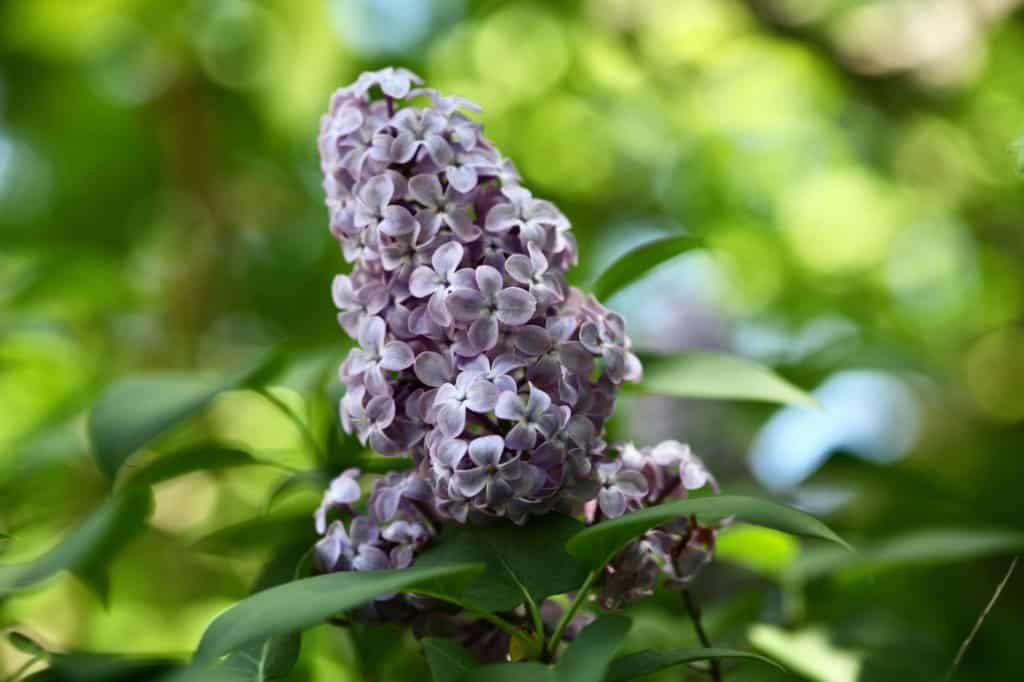






Leave a Reply